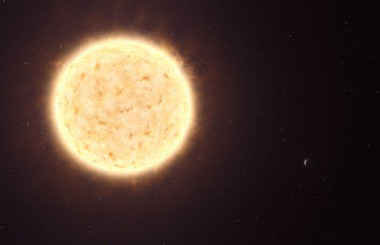Welcome Red Giant, New Visitor To Our Galaxy

Visitors tend to visit our home at any time, but this time an immigrant red giant from another galaxy has arrived in our Milky Way. It's accompanied by it's own planet, a situation that is puzzling scientists.
The star is called HIP 13044. The planet that revolves around it is called HIP 13044b. While this star is now in the Milky Way, researchers at the Germany's Max Planck Institute for Astronomy and the European Space Agency said that it originated in a separate galaxy.
It is likely the planet and its host star originated in a dwarf galaxy that was swallowed by the Milky Way galaxy between 6 billion and 9 billion years ago. Such galactic cannibalism is an ordinary occurrence in galactic evolution.
The star and planet are 2,000 light years away in the southern constellation of Fornax (Furnace). It's in a formation called the Helmi stream, a ring of ancient stars that cuts through the plane of the Milky Way. Typically, remnants of swallowed-up dwarf galaxies can be detected as such ribbon-like arrangements of stars.
Astronomers have detected over the last 15 years nearly 500 exoplanets orbiting ordinary stars in our cosmic neighborhood. Now, for the first time, astronomers have detected an exoplanet whose origin appears to lie outside our own Milky Way galaxy.
The planet has a minimum mass of 1.25 times the mass of Jupiter, and was discovered by measuring tiny wobbles of a star caused by a planet's gravitational pull. HIP 13044's wobbles were detected with the high-resolution spectrograph FEROS at the 2.2-meter MPG-ESO telescope at the La Silla European Southern Observatory in Chile.
For the first time, astronomers have detected a planetary system in a stellar stream of extragalactic origin. Because of the great distances involved, there are no confirmed detections of planets in other galaxies. This cosmic merger has brought an extragalactic planet within our reach, said Rainer Klement of the Max Planck Institute for Astronomy.
While the host star HIP 13044 was rather similar to our own Sun earlier on, it has since gone through the 'Red Giant' phase, in which a star cools and expands to hundreds of times the radius of the Sun, the researcher said. It has now settled down into another quiet phase powered by the nuclear fusion of helium, which is expected to last a few million years.
The fact that the exoplanet survived the red giant stage provides an intriguing glimpse of one possible fate of our own planetary system -- our Sun is expected to become a Red Giant in around five billion years. HIP 13044 is about eight billion years old.
Johny Setiawan and his colleagues expect the current close orbit of HIP 13044b was initially much larger, and that the planet migrated inwards during the star's Red Giant phase. Its present average distance to its host star is a mere 12 per cent of the distance between the Sun and the Earth, with an orbital period of only 16.2 days.
There is some evidence that some closer-in planets did likewise, and did not survive: HIP 13044 is rotating relatively quickly for a star of this particular type. One explanation is that HIP 13044 swallowed its inner planets during the Red Giant phase, which would make the star spin more quickly, said Setiawan.
HIP 13044 is a very ancient, very metal-poor star, meaning it contains very few elements heavier than hydrogen and helium - less than any other star with planets.
According to astronomers, stars and their planets are made from the same initial building blocks, so if a star has few metals, the disk of material that surrounded the star when it was young -- and from which its planets are born -- would also be metal-poor.
Although gas giants are made of mostly hydrogen and helium, astronomers think planets still require an initial core of heavy elements to attract lighter gases and grow.
It is a puzzle for the widely accepted model of planet formation of how such a star, which contains hardly any heavy elements at all, could have formed a planet, said Setiawan.
© Copyright IBTimes 2025. All rights reserved.





















